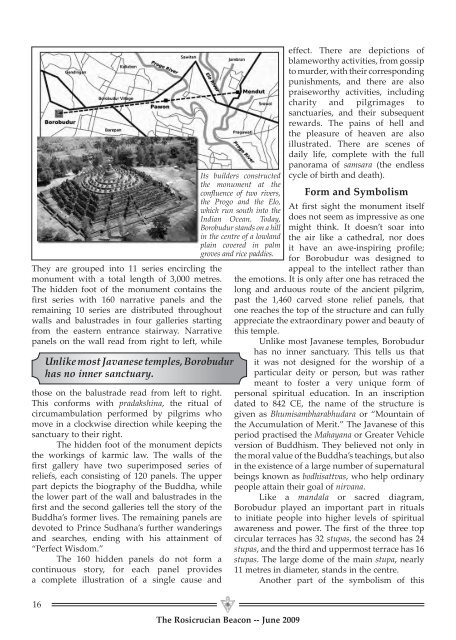RosicRucian - AMORC
RosicRucian - AMORC
RosicRucian - AMORC
- No tags were found...
You also want an ePaper? Increase the reach of your titles
YUMPU automatically turns print PDFs into web optimized ePapers that Google loves.
They are grouped into 11 series encircling themonument with a total length of 3,000 metres.The hidden foot of the monument contains thefirst series with 160 narrative panels and theremaining 10 series are distributed throughoutwalls and balustrades in four galleries startingfrom the eastern entrance stairway. Narrativepanels on the wall read from right to left, whileUnlike most Javanese temples, Borobudurhas no inner sanctuary.those on the balustrade read from left to right.This conforms with pradakshina, the ritual ofcircumambulation performed by pilgrims whomove in a clockwise direction while keeping thesanctuary to their right.The hidden foot of the monument depictsthe workings of karmic law. The walls of thefirst gallery have two superimposed series ofreliefs, each consisting of 120 panels. The upperpart depicts the biography of the Buddha, whilethe lower part of the wall and balustrades in thefirst and the second galleries tell the story of theBuddha’s former lives. The remaining panels aredevoted to Prince Sudhana’s further wanderingsand searches, ending with his attainment of“Perfect Wisdom.”The 160 hidden panels do not form acontinuous story, for each panel providesa complete illustration of a single cause andIts builders constructedthe monument at theconfluence of two rivers,the Progo and the Elo,which run south into theIndian Ocean. Today,Borobudur stands on a hillin the centre of a lowlandplain covered in palmgroves and rice paddies.effect. There are depictions ofblameworthy activities, from gossipto murder, with their correspondingpunishments, and there are alsopraiseworthy activities, includingcharity and pilgrimages tosanctuaries, and their subsequentrewards. The pains of hell andthe pleasure of heaven are alsoillustrated. There are scenes ofdaily life, complete with the fullpanorama of samsara (the endlesscycle of birth and death).Form and SymbolismAt first sight the monument itselfdoes not seem as impressive as onemight think. It doesn’t soar intothe air like a cathedral, nor doesit have an awe-inspiring profile;for Borobudur was designed toappeal to the intellect rather thanthe emotions. It is only after one has retraced thelong and arduous route of the ancient pilgrim,past the 1,460 carved stone relief panels, thatone reaches the top of the structure and can fullyappreciate the extraordinary power and beauty ofthis temple.Unlike most Javanese temples, Borobudurhas no inner sanctuary. This tells us thatit was not designed for the worship of aparticular deity or person, but was rathermeant to foster a very unique form ofpersonal spiritual education. In an inscriptiondated to 842 CE, the name of the structure isgiven as Bhumisambharabhudara or “Mountain ofthe Accumulation of Merit.” The Javanese of thisperiod practised the Mahayana or Greater Vehicleversion of Buddhism. They believed not only inthe moral value of the Buddha’s teachings, but alsoin the existence of a large number of supernaturalbeings known as bodhisattvas, who help ordinarypeople attain their goal of nirvana.Like a mandala or sacred diagram,Borobudur played an important part in ritualsto initiate people into higher levels of spiritualawareness and power. The first of the three topcircular terraces has 32 stupas, the second has 24stupas, and the third and uppermost terrace has 16stupas. The large dome of the main stupa, nearly11 metres in diameter, stands in the centre.Another part of the symbolism of this16The Rosicrucian Beacon -- June 2009











